Student researchers head north in search of salmon and knowledge
Six undergraduates meet 600,000 salmon in the Alaska wilderness as the UW opens up research opportunities for juniors and seniors.
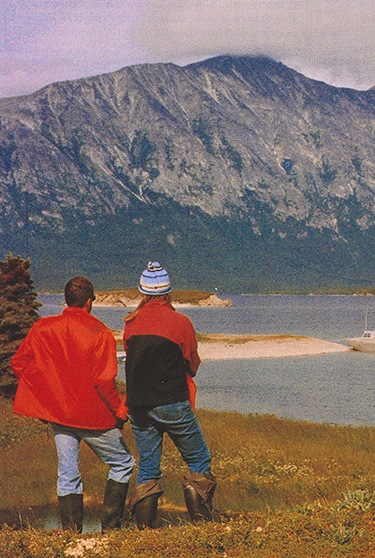
Woody Beach, Lake Iliamna, Alaska.
Five students take over the table in the center of the cabin and flip open their laptops. A sixth sits on the vinyl-covered sofa with his computer balanced on his knees.
Their assignment: estimate how many sockeye salmon should be harvested and how many should be allowed to escape and spawn in Alaska’s Egegik River. Hard drives whir, computer screens blink and fingers race across keyboards, manipulating data that was recently used by managers making decisions about real fish.
The six undergraduates begin to debate the possibilities. Mariah and Kirstin argue about estimating populations using the Ricker formula vs. the one developed by Beverton and Holt.
Then a student grabs a jacket and a flashlight and makes a one-minute walk to visit the outhouse.
Welcome to the Porcupine Island Field Station, where sophisticated fisheries science meets the Alaska bush.
Alaska is the only place in the United States where scientists can study salmon in watersheds without dams, houses, logging or other human development. These University of Washington undergraduates are doing their homework at the source—in cabins reachable only by boat or floatplane and in streams filled with thousands of flame-red sockeye salmon fighting to spawn.
The students, five from Washington and one from Oregon, are working alongside UW faculty and graduate students for six weeks, building on a half-century of salmon research.
It is the first-ever undergraduate class offered by the School of Fisheries in Alaska, according to the creators of the course, Tom Quinn and Ray Hilborn, professors of fisheries, and Dan Schindler, assistant professor of zoology. Determined to involve more undergraduates in its world-class research programs, the School of Fisheries received $137,400 from the UW’s “Tools for Transformation” fund to do just that. The fund is a special pool of money created by the University to, among other things, serve students in new ways.
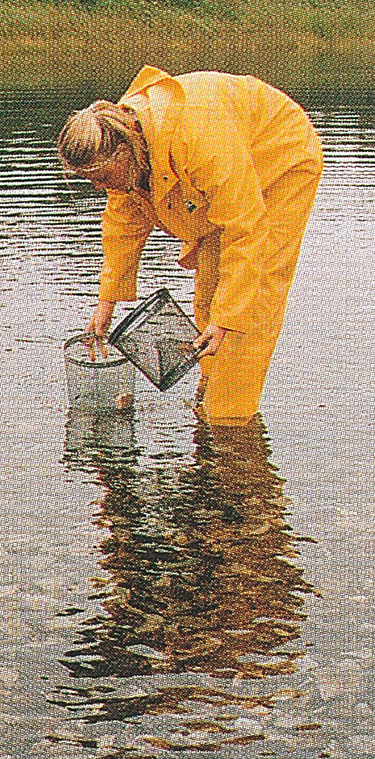
Undergraduate Kirstin Holsman cleans a fish trap.
Their Alaskan “classrooms” go back a long way—before Alaska was even a state. In 1946 the federal government asked the UW to investigate declining salmon runs in Southwest Alaska. The UW set up its first research station in 1947 at Aleknagik and has six in all. At that time, the biology of salmon was poorly understood. There were no long-term studies integrating salmon and their ecosystems. So UW researchers developed many basic techniques for counting salmon and understanding their life cycle.
While initially launched to help industry and the federal government understand the size of salmon runs, early leaders of the program such as Bud Bergner, Ole Mathisen and Don Rogers also collected basic information about weather, lake levels, emerging insects, zooplankton levels, other fish species and juvenile salmon growth. It’s one of the longest-standing data sets about salmon ecology in the world.
These 54 years of research provide priceless data about the size of salmon populations and basic salmon biology. It’s information that’s needed to help sort out what might work—and what mistakes to avoid—as policy makers and citizens struggle with endangered salmon runs in Washington, Oregon and Idaho.
Students added to that knowledge as they worked Hansen Creek near the Aleknagik Field Station. It is the kind of place most of us only read about: a creek thick with sockeye, more than 7,000 some days, in a body of water a little more than a mile long. The creek itself is only five feet wide and ranges in depth from 3 inches to a foot and a half. In the shallows salmon fight for mates and guard their nests, called “redds.” Muddy outcrops are criss-crossed with bear tracks and littered with fresh and decaying salmon carcasses, many half stripped to the bone by bears.
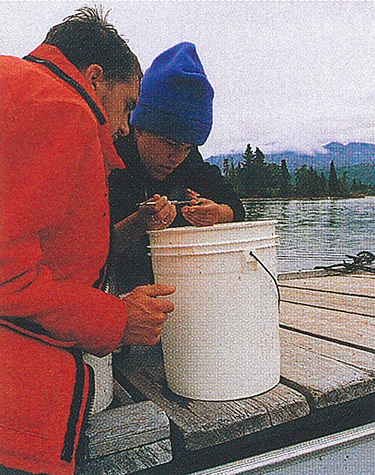
Tom Wadsworth and Kai Chamberlain check a water sample to estimate fish counts.
Professor Quinn has a multi-year research program in the area comparing salmon populations for such things as differences in body size, body shape, age, physical habitat and bear predation.
At each stream that is surveyed, students weigh fish, measure their length and the depth of their bodies, and gather information about average ages. They measure the streams to determine such things as how shallow it is at its mouth. Quinn says some streams have sand or gravel sills at the opening where the water may be only an inch deep. It’s a barrier that strands a lot of fish, particularly the larger ones.
This simple observation begins the trade-offs that fish biologists consider when studying which fish spawn and which die before they get the chance to mate. For instance, large fish are better at fighting rivals but are also more likely to become stranded in the shallow water. Fish that are first to arrive may all be eaten by bears, but fish that arrive last may miss out on the best redd sites. Females prefer deep-bodied males (males can be between 6 to 12 inches from their fin to their bellies) but fish sticking higher out of the water are easier for bears to bite.
The observational work prompts a later class discussion. Students Tom Wadsworth and Chris Sarver make an interesting point. They’d always understood that males abandon the females after spawning. But in Hansen Creek it didn’t look as if just the females guard their redds. Both students saw males sticking around even after they’d spawned and even though they could mate with other females. Greg Buck, a UW graduate student assisting with the class, confirms that sometimes large males have been known to help guard redds.
Enthused by the field work—senior Kirstin Holsman said she learned more in the first two weeks than in a whole quarter of some classes back on campus—the students survey four more streams than planned. Most choose salmon behavior as the subject of their independent projects, one of the course requirements.
Kristi Overberg, for example, focuses on five creeks, comparing the shapes of fish and the physical variation of the streams to which they returned. Sarver conducts an experiment that shows 90 percent of fish return to the redds they established in a small pond if they are moved 200 feet downstream from the pond. Only 50 percent of the fish that are moved 200 feet upstream, however, make it back to their redds.
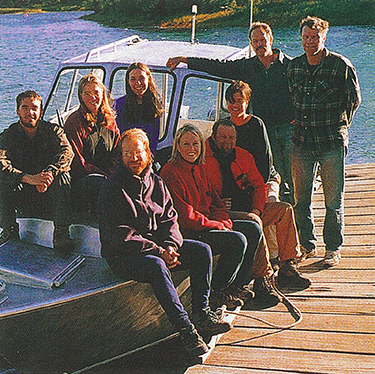
The UW’s “Team Alaska” included six undergraduates for the first time. Front row seated, left to right: Chris Sarver, Kirstin Holsman, graduate student Greg Buck and Kai Chamberlain. Back row seated: Tom Wadsworth, Kristi Overberg and Mariah Meek. Standing: Professors Tom Quinn and Ray Hilborn.
The independent project is one of the toughest course assignments. Six weeks sounds like plenty of time to choose a project and conduct experiments, however, the students are somewhat taken aback at having to select a topic almost from a dead start. “We arrived so close to the start of spawning at Aleknagik that those of us considering spawning research were told, ‘Well, spawning starts in four days so you need to plan and do your pre-spawning work tomorrow,’ ” says Kai Chamberlain.
Chamberlain volunteers to help next summer’s class before they leave and says she hopes students in coming years can build on the projects she and her classmates are doing. The other students concur quickly and enthusiastically.
The class helped build a record of research that provides Alaska fisheries managers and industry with data about salmon abundance and provides scientists in Alaska, the Pacific Northwest and elsewhere with information about basic salmon biology.
Among other things, fisheries and climate scientists are using UW data to correlate salmon runs with a 20- to 30-year climate cycle over the North Pacific. Called the Pacific Decadal Oscillation, researchers recently discovered that when the climate cycle is in its warm/dry phase, as it has been since 1977, Alaskan salmon runs are more abundant and Pacific Northwest salmon runs suffer. When the climate shifts to its cool/wet phase, Alaskan runs are weaker and the Northwest salmon have more favorable conditions.
There is something about the climate cycle that affects ocean conditions and, in turn, the salmon. For Alaska, Hilborn says the UW Alaska Salmon Program would like to investigate ocean conditions, and ways to keep track of them more thoroughly. Scientists are still struggling to understand what happened two years ago when the sockeye runs in Bristol Bay were half as large as projected. After ruling out numerous other causes as minor contributors, ocean conditions emerge as the key culprit but what happened remains unclear, Hilborn says.
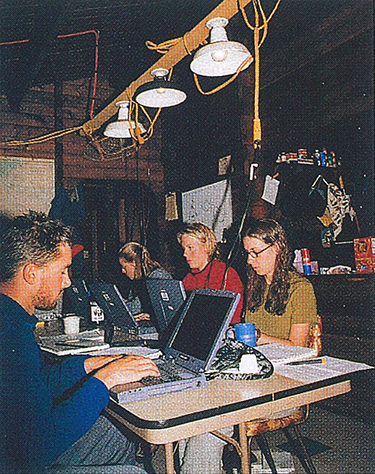
Homework in the bush did not stop undergraduates from using their laptops. Left to right: Tom Wadsworth, Kristi Overberg, Kirstin Holsman and Mariah Meek.
For the Pacific Northwest, the study of ocean conditions and impacts on salmon in Alaska might provide a clearer picture of how ocean conditions affect runs in that area. Other than harvesting, the Alaskan runs being studied are unaffected by human activities, so it should be easier to see the natural connections. In the Lower 48, scientists must peel away the effects of urbanization, agriculture, power generation and other activities in order to study natural cycles.
It’s important to understand how ocean conditions affect Pacific Northwest runs, Hilborn says. “In a few years, if the Pacific Decadal Oscillation shifts to the phase that favors our runs, we don’t want to be patting ourselves on our backs for ‘saving’ salmon when we still haven’t done enough as far as habitat, hatcheries and other problems salmon face,” he says.
Zoologist Schindler says he may one day be able to extend the salmon abundance record back for centuries by taking core samples from the sediments of Alaskan lakes and analyzing their isotope composition. Correlating these numbers with climate records may reveal new climate patterns that affect salmon survival and the Alaskan ecosystem.
Pursuing these and other lines of research often means using techniques never tried before and sometimes ending up with more questions than when the work started—something the undergraduates also faced.
After their return to Seattle, the six attended weekly classes as part of a Fall Quarter seminar that capped their experiences and included presentations about their independent projects.
Senior Mariah Meek reported about her work trying to confirm if fish are as discriminating as what she observed among beach spawning salmon: It appeared that males in an area where the females had all spawned were unwilling to swim even a couple hundred meters to another area of the beach where females were still available.
“I had to think through the project and put it all together whereas, for most classes, I’m simply writing about what I’ve already read or been told is true,” Meek says. “This kind of work has made a strong, lasting impression, on me. It confirms that this is the kind of work I want to be doing.”